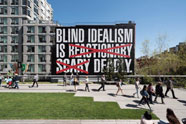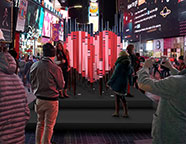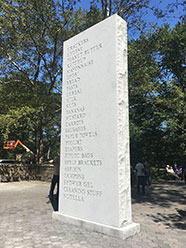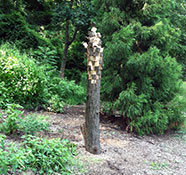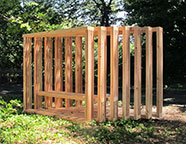Art in the Parks
Through collaborations with a diverse group of arts organizations and artists, Parks brings to the public both experimental and traditional art in many park locations. Please browse our list of current exhibits and our archives of past exhibits below. You can also see past grant opportunities or read more about the Art in the Parks Program.
Public Art Map and Guide
Find out which current exhibits are on display near you, and browse our permanent monument collection.
Search Current and Past Exhibits
2017
Manhattan
Barbara Kruger, Untitled (Blind Idealism Is...)
March 21,2016 to March 2017
The High Line, Manhattan
Map/Directions (in Google Maps)
Please note: This is a past exhibit that is no longer installed in the park.
Barbara Kruger is an American artist who works with pictures and words. Kruger uses the fluency she developed as a graphic designer for publications such Mademoiselle, House & Garden, and Aperture, to inform her work as an artist, insistently addressing the issues of power, property, money, race, and sexuality. Over the past three decades her work has ranged from the photographic merging of image and text, to immersive video installations, to room-wrapping textual exhibitions, to large-scale outdoor displays of words and images. Two of her best-known works – Your body is a battleground and I shop therefore I am – also showcase the feminist overtones of her artworks, and her concentration on women as a lucrative site for advertising and consumerism.
For the High Line, Kruger presents Untitled (Blind Idealism Is…), a new work realized as a hand-painted mural. Continuing her unabashed criticism of culture and power, the mural features the slogan “BLIND IDEALISM IS REACTIONARY SCARY DEADLY,” an adaptation of a quote from Afro-Caribbean philosopher and revolutionary thinker Frantz Fanon, which has appeared in multiple works by the artist. The original statement by Fanon, “Blind idealism is reactionary,” suggests that political and religious convictions stem from the situations from which they grow, not from the inherent nature of individual human beings. According to Kruger, the work reflects “how we are to one another” within “the days and nights that construct us.” These texts, along with Kruger’s own writings, resonate with particular potency in today’s political climate.
![]()
Dee Briggs, Dee Briggs in Foley Square
April 11, 2016 to March 31, 2017
Thomas Paine Park, Manhattan
Map/Directions (in Google Maps)
Please note: This is a past exhibit that is no longer installed in the park.
Dee Briggs’ three new sculptures for Dee Briggs in Foley Square directly address her fascination with geometry and the particular operation of symmetry called chirality or three-dimensional handedness. Chirality is defined by a three dimensional entity that has no internal plane of symmetry along the x, y or z-axis.
Briggs states that her work “grows out of mathematics and architecture – geometry, symmetry and rhythm – line, plane and volume – visual perception and spatial understanding. They are three-dimensional patterns that are at once familiar and foreign. Heavy forms that imply weightlessness creating a tempting and engaging spatial experience.”
![]()
Nari Ward, Smart Tree
April 2016 to March 2017
The High Line, Manhattan
Map/Directions (in Google Maps)
Please note: This is a past exhibit that is no longer installed in the park.
Inspired by a building adjacent to the High Line that had been transformed into an indoor parking lot, Nari Ward reconfigures a memory from his childhood for his High Line Commission, Smart Tree. Returning to his father’s home in Jamaica after fifteen years away, Ward remembers finding one of two abandoned cars in the front yard sprouting a lime tree. He reimagines this fantastical story for the High Line in the form of a Smart car refinished with strips of tire treads and propped up on cinder blocks. In place of a lime tree, Smart Tree will feature an apple tree growing out of its roof, adapted out of necessity for its North American context. With the car’s cinderblock base representing stasis, and its coating of tire treads suggesting perpetual movement, Ward’s Smart Tree holds up a mirror to the flux surrounding the High Line itself and reminds viewers of the High Line’s history as a major transportation artery in Manhattan.
This exhibition is presented by the Friends of the High Line.
![]()
Kathryn Andrews, Sunbathers I & II
May 2016 to March 2017
The High Line, Manhattan
Map/Directions (in Google Maps)
Please note: This is a past exhibit that is no longer installed in the park.
For the High Line, Kathryn Andrews presents her first public art commission, responding to two contrasting aspects of the elevated park: its relationship to nearby billboards and to the natural landscape. Andrews describes the High Line’s environment as a “hyper-surreal image world,” composed of large-scale advertisements and commercial signs that surround park visitors as they stroll high above the bustling cityscape. Andrews notes, by contrast, that the High Line’s physical design offers visitors a chance to develop awareness of the body in relation to extreme natural weather conditions including intense winds, rain, snow, and sun.
Andrews’s first sculpture, Sunbathers I, is a towering box-like structure, silkscreened with a black-and-white stock image of a public beach sign that announces, “Beyond This Point You May Encounter Nude Sunbathers.” Installed at West 18th Street, the sculpture houses misting nozzles that spray water intermittently at passers-by. Placing this work on the High Line, where nudity is not allowed draws attention to the more risqué social mores displayed on nearby billboards. The second sculpture, Sunbathers II, installed under The Standard, High Line, is a large, horizontal aluminum box containing a giant fan and featuring a photograph of an ice cream cone. The fan’s movement is juxtaposed with the adjacent static image, mirroring the park itself.
This exhibition is presented by the Friends of the High Line.
![]()
Various Artist, Wanderlust
April 21, 2016 to March 2017
The High Line, Manhattan
Map/Directions (in Google Maps)
Please note: This is a past exhibit that is no longer installed in the park.
Wanderlust is a group exhibition that explores the themes of walking, journeys, and pilgrimages. Inspired by the High Line as an ambulatory space experienced most naturally in motion, Wanderlust extends the tradition of Conceptual art wherein the act of walking served as an inspiration for many artists who explored life both in the urban context and in an ambivalent confrontation with nature.
On the High Line, itself an urban promenade that combines nature and architecture, the act of walking is both celebrated and taken for granted. Wanderlust invites viewers to remember the many implications of the journeys and walks they take every day, placing them within a secular tradition that expands beyond art into both everyday life and our shared cultural histories.
Wanderlust will feature eleven international artists: Giorgio Andreotta Calò, Valentin Carron, Iman Issa, Matt Johnson, Marie Lorenz, Tony Matelli, Paulo Nazareth, Mike Neslon, Roman Ondak, Susan Philipsz, and Rayyane Tabet.
This exhibition is presented by the Friends of the High Line.
![]()
The Office for Creative Research, We Were Strangers Once Too
February 7, 2017 to March 5, 2017
46th Street and 7th Avenue
Father Duffy Square, Manhattan
Map/Directions (in Google Maps)
Please note: This is a past exhibit that is no longer installed in the park.
We Were Strangers Once Too is a public data sculpture highlighting the role that immigrants have played in the founding, development, and continued vibrancy of New York City. Data from the 2015 American Census Survey takes visual, sculptural form in 33 metal poles, inscribed and hued to represent the national origins and shifting populations of foreign-born NYC residents. As visitors travel around the sculpture to a designated observation point, their perspective shifts until the individual color blocks of red and pink resolve into an iconic heart.
Conceived as both a striking visual object and as a point of dialogue and conversation, We Were Strangers Once Too champions the value of diversity in the city, and specifically the city’s immigrant populations, new and old, at a time when they are increasingly under siege.
This exhibition is presented by the Times Square Alliance and the Urban Design Forum.
![]()
David Shrigley, MEMORIAL
September 8, 2016 to February 12, 2017
Doris C. Freedman Plaza
Central Park, Manhattan
Map/Directions (in Google Maps)
Please note: This is a past exhibit that is no longer installed in the park.
MEMORIAL is a new sculpture by David Shrigley consisting of a 17 foot tall slab of granite which has been meticulously engraved to feature an everyday grocery list. The object plays on the historical significance of granite public monuments, often erected to celebrate and remember great endeavors, but Shrigley’s universal monument pays homage both to no-one and to everyone. It honors and memorializes the small act of making a grocery list, familiar to so many–a simple ode to humanity.
This exhibition is presented by Public Art Fund
![]()
Audrey Shachnow, Golden Pears
August 22, 2016 to January 1, 2017
Fort Tryon Park, Manhattan
Map/Directions (in Google Maps)
Please note: This is a past exhibit that is no longer installed in the park.
Audrey Shachnow makes large scale sculptures with the purpose of creating beauty in everyday objects. Her large scale installation of "Golden Pears” highlights the connection between the importance of the earth's natural environment and its ability to support the food we grow to sustain life. The Golden Pears invite a dialogue between the trees and the park setting, reminding us of the importance of preserving nature.
Evolving Terrain brings together four artists’ work, placed throughout Fort Tryon Park. The show includes work by artists Anthony Heinz May, Audrey Shachnow, Tom Monsees, and Matthias Neumann. Their work addresses the natural landscape within an ever-changing city, and hopes to create a dialogue between communities, artists, and nature, and the ways in which the natural realm supports the built environment.
This exhibition is presented by the Northern Manhattan Arts Alliance and the Fort Tryon Park Trust.
![]()
Anthony Heinz May, Persieverrance
August 22, 2016 to January 1, 2017
Fort Tryon Park, Manhattan
Map/Directions (in Google Maps)
Please note: This is a past exhibit that is no longer installed in the park.
Persieverrance is an intentionally misspelled version of the word perseverance. Containing three parts (per-sieve-errance) the word-jam sounds phonetically like perseverance, but misspelled to engage in this compositional reconstruction of natural tree waste found in the park. The title suggests processes observed in the fragmented assemblage and questions relations between nature, humans and technology. The breakdown of the recycled tree trunk into equal-sized units portrays scientific instrumentality involved in the removal of natural material from cycles that benefit all life on Earth, for human salvation and profiteering.
Evolving Terrain brings together four artists’ work, placed throughout Fort Tryon Park. The show includes work by artists Anthony Heinz May, Audrey Shachnow, Tom Monsees, and Matthias Neumann. Their work addresses the natural landscape within an ever-changing city, and hopes to create a dialogue between communities, artists, and nature, and the ways in which the natural realm supports the built environment.
This exhibition is presented by the Northern Manhattan Arts Alliance and the Fort Tryon Park Trust.
![]()
Matthias Neumann, bench V (basics)
August 22, 2016 to January 1, 2017
Fort Tryon Park, Manhattan
Map/Directions (in Google Maps)
Please note: This is a past exhibit that is no longer installed in the park.
“bench V (basics)” is a site-specific installation that continues the artists’s “basics” series of work, exploring an abstracted notion of form, material, space and utility. “Basics” is based on a constructive logic of additive 2x4 wood studs that allow a monumentality through every-day means. The work can be experienced both as an abstract sculptural gesture and interactive spatial environment. “Basics” encourages an uncertainty in the dialog between the viewer and the work, opening possibilities in the public quality and appropriation of the work. The temporality of the site-specific intervention is mirrored by the material and constructive logic of the work.
Evolving Terrain brings together four artists’ work, placed throughout Fort Tryon Park. The show includes work by artists Anthony Heinz May, Audrey Shachnow, Tom Monsees, and Matthias Neumann. Their work addresses the natural landscape within an ever-changing city, and hopes to create a dialogue between communities, artists, and nature, and the ways in which the natural realm supports the built environment.
This exhibition is presented by the Northern Manhattan Arts Alliance and the Fort Tryon Park Trust.
![]()
